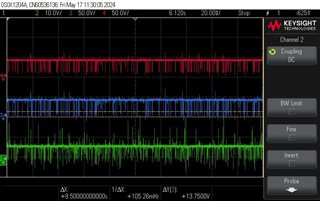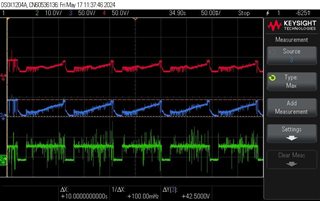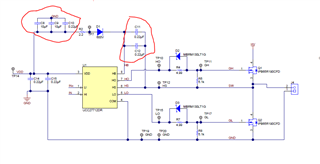Dear TI Team,
We are facing some issue with UCC27714 driver ( specially at HO & boot caps).
System detail:
Input voltage: 33-34V
Input current :60A
Output voltage: 30V
Output current: 60A( but we are still at 10-15A Only due to this issue)
Switching frequency 230Khz.
Case 1: Below is the attached waveform of HI_Pin (Green), HO_Pin (Blue) & HB_Pin ( RED) waveforms.
at 10-15A load it seems working fine, As show in below image.
Case2: As we start to increasing load above 15A, then the HO pin waveforms getting corrupted, as shown in below image ( HI_Pin (Green), HO_Pin (Blue) & HB_Pin ( RED) waveforms )
HI ON time ~ 80mSec
HI OFF time ~ 20mSec.
Below is the UCC27714 components details:
1) VDD =12V
2) CVDD=470uF
3) CBOOT = 470nF
4) RBOOT =5R1
5) DBOOT = SS320LWN
6) MOSFET Qg = ~100nC.
7) Rgate = 1R
8) RHI & RLI = 51R
9) CHI & CLI = 220pF
We also tried different CVDD & CBOOT values keeping same DBOOT, RBOOT, VDD etc. But result is the same issue ( Issue still persist)
Case1:
1) CVDD = 1uF
2) CBOOT= 47nF, 100nF & 470nF
Case2:
1) CVDD = 470uF
2) CBOOT= 47nF, 100nF & 470nF
Case3:
1) CVDD = 4.7uF
2) CBOOT= 47nF, 100nF & 470nF
Note: We also monitored the 12V line, it seems constant, there is no change in 12V line nor any fluctuation observed.
-
Ask a related question
What is a related question?A related question is a question created from another question. When the related question is created, it will be automatically linked to the original question.







